 |
|
 |
|
 |
|
 |
|
 |
|
 |
|
VEHICLE SUSPENSION LINKAGE
I call it the "Twers Linkage Suspension"
United States Patent #8,376,382
Canadian Patent #2,706,678
---
BICYCLE CHAIN GUIDE
No marketing name assigned
United States Patent #8,991,846
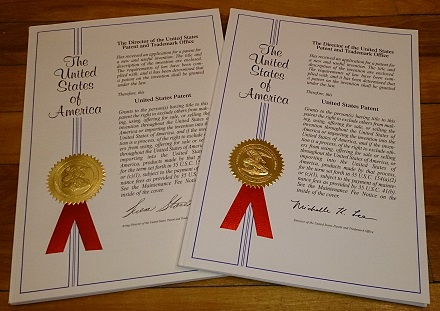
Pro Se
|
VEHICLE SUSPENSION LINKAGE United States Patent #8,376,382 Canadian Patent #2,706,678
---
BICYCLE CHAIN GUIDE United States Patent #8,991,846 |

Pro Se |
This is the column where I try to explain the what why and how of the inventions featured in the prototype.
|
This is the column where I let myself keep more of my sense of humour in the explanation.
|
|
The Twers Linkage Suspension.
This patented suspension linkage generates a rearward arcing wheel path based on a logarithmic spiral. The wheel path is constrained to a region of maximum effectiveness. A floating virtual pivot location (19) is approximated as a single point but can be understood to move along the line composed from the intersection points of the right bisectors of the wheel path curve. |
I demonstrate it with Popsicle sticks.
I'm tired of graphs and CAD animations; if it works, it works. When someone tells you how something works, I encourage you to try to understand and confirm what you're being told/sold. |
|
Why a Rearward (arcing) Wheel Path? |
|
|
Vector Physics. This is where we introduce magnitude to direction. When we talk about speed, we're likely all familiar with magnitudes and units like 60km/h (about 35mph). Vector Physics asks us to specify "in what direction"? When we talk about speed with a direction we call it Velocity. When you ride a bicycle it is advantageous to think of Velocity instead of simply speed. |
Assumption 1 - The Bicycle Moves Forwards.
That isn't really much of a breakthrough statement but it forms the foundation of the rest of the discussion. Without getting too descriptive about direction I'll simply propose that we work with a direction system that will let us say things like: Forwards - Backwards - Towards - Away From. I simply need to establish the set-up for the next concept in Physics: Relative Velocity. |
|
Relative Velocity. If you ride a bike at an obstacle someone can look at it from an external frame of reference and say: The bike is approaching the obstacle But as you may have noticed, if you're riding the bike, it can appear that: The obstacle is coming towards the bike. So let's take our frame of reference to be, well, ourselves. This gives us an appreciation for having the wheel path contain a rearward component of motion when we want to absorb the imminent impact of an obstacle that appeared to be coming towards us. |
I think that we could all agree that, using our self based frame of reference and our informal direction system,that: "OUT OF THE WAY"
|
Why Not a Completely Rearward Wheel Path? |
|
The wheel path arcs backwards and upwards at the start of the stroke and increases the upward component as the requirement to absorb a vertical component increases. |
If you're trying to get past something, direct avoidance is helpful but eventually you will have to get over it. |
So What Does This Do For The Ride? |
|
The suspension linkage gives you a feeling close to hovering. |
Testimonials and Quotes are not Science. The comment from the only rider that I've let try the prototype on a trail was that it feels like riding on a cloud. That was my mission; mission accomplished. |
|
CONCERNS |
|
| Before we get into the other benefits that came along with this linkage let's look at how we have to deal with situations that we've introduced.
Isn't that going to have a lot of chainstay growth? - Austin D. Yes. If you're not familiar with that terminology it simply means that the bike's rear axle gets further away from the Bottom Bracket (and thus cranks) as the suspension activates. A derailer usually does the job of taking up the variation in chainstay length. The prototype TrebuChat has 5.25" (13.3cm) of chainstay grow. That is more than a lot. Previous suspension designs with notoriously high amount of chainstay grow had values typically less than 3" (7.6cm) of chainstay grow. The top or tension portion of the chain runs over a pulley that moves with the suspension to feed chain back into the system to accommodate for that portion of chainstay lengthening. The lower or return portion of the chain runs over a chain guide pulley mounted to a rotating plate that is linked to the suspension. This also feeds chain back into the system, timed in motion and magnitude to the activation of the suspension. This functionality was split into two separate patents. The upper portion tension adjustment was mentioned in the patent documentation for the patented Vehicle Suspension Linkage. The lower portion handling device was developed separately and granted a patent as a stand alone invention. The patented Chain Guide has applications to other suspension linkages that have lower portion chain grow. 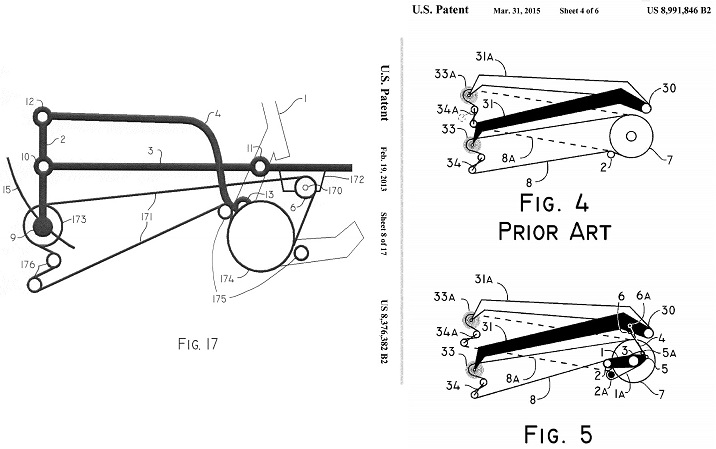 |
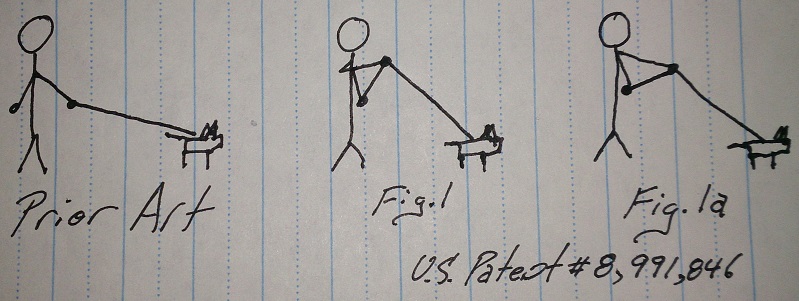
Above: not the actual Figures from the Patent Application. That much chainstay growth and the derailer doesn't move enough to activate the clutch. |
|
What About Rotational Braking Forces? If we attached a rear brake caliper to the FOOT link of the suspension then rotational inertia and leverage from braking would activate the suspension. A floating brake isn't really anything new, it simply creates a geometric link that isolates rotation forces. Doesn't that floating brake linkage hang kinda low? Down, yes; Low, not really. If you view the bike from the side you'll notice that the bulk of the floating brake linkage actually sits above the upper portion of the chain. Keep in mind that the chain is directed upwards and sits higher than it does on many bikes. |
|
|
ADVANTAGES |
|
|
Having taken care of concerns that we've introduced; let's look into what happens in terms of pedaling and braking. If we look at what happens when a vehicle like the prototype accelerates from pedaling or braking (negatively accelerates) we need to understand that we probably want to include the mass of the rider in the calculation. We then also need to look at the location of the mass of the rider. Given that you ride a DH bike standing up, the center of gravity of the rider is above that of the bicycle. The reaction force of pedaling and (rear wheel) braking on any bike originate at the rear axle. That's where the push or pull happens. When people look at pedaling and braking forces there is often the approach of looking at where the pull or push happens and where the pivot or virtual pivot is located on the frame. If we looked at the bike alone, pushing the rear axle forward would cause the suspension linkage to direct an upward force at the frame. Pulling backwards on the rear axle would cause the suspension to dive. |
To set ourselves up for the following discussion we get to the next assumption: Assumption 2 - The Rider Has Mass.
I have the means to take 20lbs off the prototype. It involves diet and exercise. By definition: the bicycle is a vehicle; you are the projectile.
When I was explaining the nuances that this situation created to a friend of mine, the statement came back: "Wait a minute.
A 50lb bicycle and a 200lb rider?
You wouldn't stack a bookcase like that." 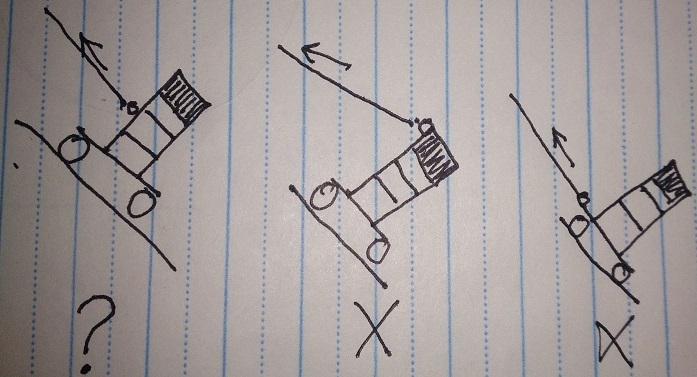 |
|
Pedaling |
|
|
Let's consider the rider's mass and centre of gravity in the experiment. We find that: the rear axle, the virtual pivot and the combined centre of mass of the bike and rider - all fall along the same basic line*. The upward component of force directed to the bicycle and, subsequently, the rider serves to accelerate the combined mass of the rider and bicycle. Riders will also contribute another force to the bicycle when pedaling in a standing position, a downward inertia from the pedal stroke. The choppier the pedal stroke, the more downward inertia. The more abrupt the acceleration at the rear axle, the more abrupt the upward force on the frame. Pedaling doesn't lock-out the suspension. The forces are transferred towards the combined center of mass to make the bicycle and rider move forward. Pedaling forces aren't isolated; they're directed.
|
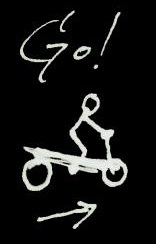 This is a sketch of how I thought that the physics would make the bike feel. The classic cartoon version of an inanimate object leaning forward into accelerating. It does actually feel this way until you figure out that you don't have to lean as far forward over the front end of the bike to get the acceleration forces to propel your centre of mass forward. This concept of no longer needing to compensate for something can be better felt and explained in the braking section. |
|
Braking |
|
|
This is the effect that can be felt in even a parking lot coasting test. Remember the concept of centre of gravity, rear axle and virtual pivot alignment from the pedaling discussion. In almost every case I get the same feedback from the parking lot braking effects demo. The test rider gets the bike coasting along and then pulls the rear brake. The report is that the suspension dives. And you can see it, it really dives. Then you advise the rider that they don't have to do that thing that they've had to do on other bikes; they can stop transferring their weight when they hit the rear brake. Because of the direction of force they can simply pull the brake. When you feel it, it's a little disturbing; the rear brake stops YOU. Braking forces aren't isolated; they're directed.
I actually use this aspect of the linkage's kinematics when heading off drops with very short landings. I can feather the rear brake when I land to slow down without taking weight off the front wheel or throwing myself over the bars. |
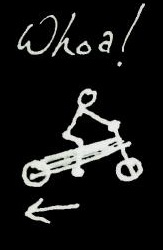 Just like the pedaling sketch above, this is how I thought it would feel. It turns out that hitting the rear brake makes it dive and go into a slack, panic mode, geometry. The with a little bit of understanding/explanation you learn that the bike/suspension isn't diving; you are. You've been compensating for braking forces; they're now directed towards your centre of mass. |
|
Kinematics Summary |
|
|
The Twers Linkage Suspension:
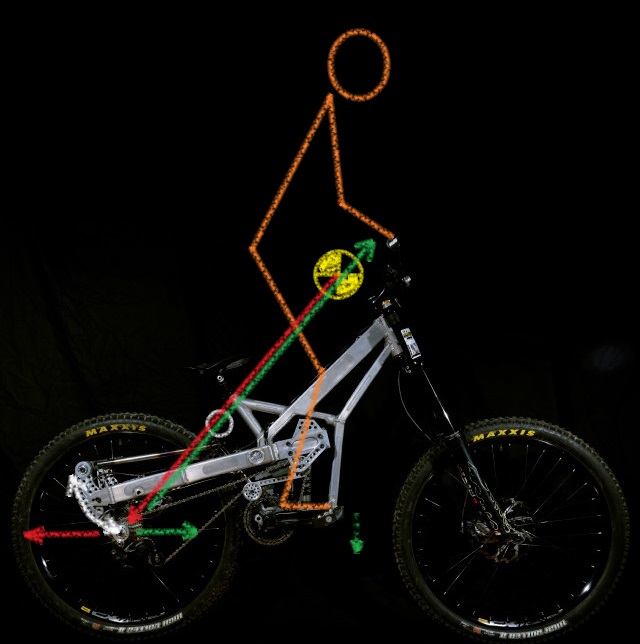 |
This brings us to Assumption - 3 When the rider pedals or applies the brakes, it is because they want something different to happen.
I wanted it. I invented it. I understand it. I patented it. I built it. I ride it. I proved it. This is me explaining it. Marketing and selling is where I'm going to have to hand this over. |